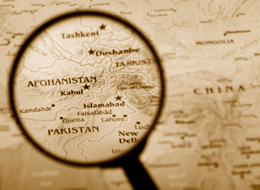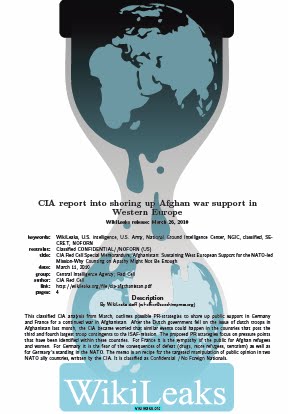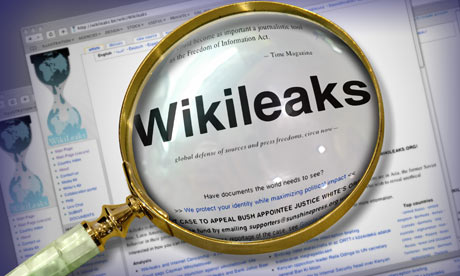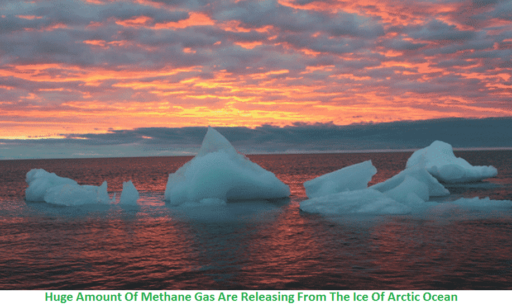WikiLeaks Releases Afghan War Reports in Unprecedented Leak.WASHINGTON, July 26 US officials in Afghanistan have long suspected Pakistan of secretly supporting the Taliban while taking massive amounts of American aid, according to military documents leaked by WikiLeaks yesterday…..
A website called WikiLeaks just published secret documents related to the United States’ war against the Taliban in Afghanistan. The documents detail deals, armed conflicts, strategies, politics, intelligence operations and some casualties from 2004 and 2010, painting the most complete publicly available picture of the Afghan War yet.
The event is in some ways comparable to the leak of the Pentagon Papers, a set of documents that provided a behind-the-scenes look at the American war in Vietnam. Those papers reached the public in 1971. At more than to 90,000 reports, WikiLeaks’ Afghan War Diary is even more substantial. By some measures it is the biggest intelligence leak to date.
A number of readers submitted word on the massive WikiLeaks release of Afghanistan war documents. “The data is provided in CSV and SQL formats, sorted by months, and also was rendered into KML mapping data.” WikiLeaks provided the documents in advance to the New York Times, Der Spiegel, and the UK’s Guardian the latter also has up a video tutorial on how to read the logs.
Turns out Collateral Murder was just a warm-up. WikiLeaks just published a trove of over 90,000 mostly-classified U.S. military documents that details a strengthening Afghan insurgency with deep ties to Pakistani intelligence.
This situation is different in that it’s not just more material and being pushed to a bigger audience and much sooner … but rather that people can give back. So people around the world who are reading this are able to comment on it and put it in context and understand the full situation. That is not something that has previously occurred. And that is something that can only be brought about as a result of the Internet.
Two months ago, we put WikiLeaks first in a list of innovative websites that could reshape the news. The site accepts submissions of confidential political or corporate documents, reviews them to make sure they’re accurate, then publishes them on the web for anyone to see. WikiLeaks has previously leaked e-mails from Vice Presidential candidate Sarah Palin and a video of U.S. soldiers killing civilians.
Assage was careful to point out that the Afghan War Diary is comprised of old reports, not future military plans, so its usefulness to NATO’s enemies in the battlefield should be limited. The people able to make the most informed decisions about whether or not the release of information can endanger American interests or lives are those working inside the Pentagon, but those are the very people WikiLeaks is trying to keep accountable. The controversy of values is clear.
WikiLeaks is able to solicit submissions from all over the world while avoiding jurisdiction by operating in several countries at once — or none at all, depending on your interpretation of the situation. This wasn’t possible before the web. Now it is, and the implications for society are significant.
The Afghan War Diary was simultaneously given to reporters from The New York Times, The Guardian and Der Spiegel several weeks in advance so those reporters could study the documents and provide context with their public release. It was also given to those three publications so that no one national government could censor it.
WikiLeaks removed data that could implicate its sources, but the U.S. military already has an alleged WikiLeaks source in custody: 22-year old intelligence analyst Bradley Manning, who The Guardian says is suspected as the source of the video that depicted U.S. soldiers killing civilians. So far we’ve seen no evidence for or against any connection between the Afghan War Diary and Manning.
Politico reports that The White House released a critical statement in response to the leak, saying the U.S. “strongly condemns” the disclosure. The statement criticized WikiLeaks for not approaching the White House for comment or verification, and claimed that the bleak logs record events that took place before the Obama administration’s change in strategy.
The three publications given early access to the reports have made a few similar observations about what they say. Foremost is the general narrative that the situation in Afghanistan is bleaker than any of the governments involved would have you believe, particularly when it comes to collaboration between the United States and Pakistan.
Several reports either directly or indirectly implicate the ISI, a Pakistani intelligence agency, in aiding Taliban fighters. There are some suggestions in the reports that current or former members of the ISI have actually met with Taliban and Al Qaeda leaders to collaboratively organize attacks on American troops.
A website called WikiLeaks just published secret documents related to the United States war against the Taliban in Afghanistan. The documents detail deals, armed conflicts, strategies, politics, intelligence operations and some casualties from 2004 and 2010, painting the most complete.
However, the New York Times notes that some of the reports on that subject come from Afghanistan intelligence, which has a negative relationship with Pakistan and a potential interest in damaging its reputation. Other reports detail NATO-ordered civilian killings, specifics as to why NATO progress has been slow at best, and other bleak pictures of the activities in the war.
Apart from the WikiLeaks website, you can find report specifics in an interactive map The Guardian produced to highlight 300 critical reports found in the leak.
Resources :mashable.com,tmdcelebritynews.com







Pingback: refd